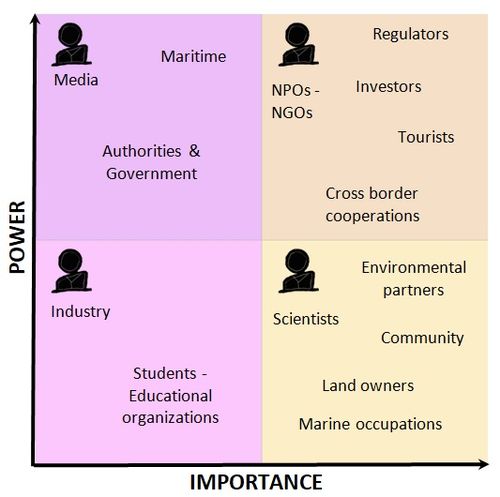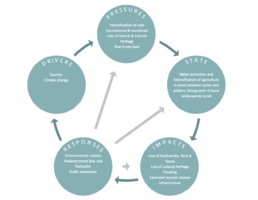COLAND Case Study 2020 - Bray-Dunes: Difference between revisions
Nicole.leung (talk | contribs) |
|||
| Line 27: | Line 27: | ||
= Rationale = | = Rationale = | ||
The first keyword is dynamic, in terms of the protected landform and high biodiversity. In Bray-Dunes right adjacent to the Belgian border there is 250 hectares National Nature Reserve of the Dune Marchand classified in 1974 to protect the dunes of Flanders. The landform possesses high biodiversity of plant species and is home to many land animal and underwater species. | |||
The second key word is memories, reflecting the historical significance of Bray-Dunes. Bray-Dunes was a significant site during World War II, and it is the site of many casualties during the period of Dunkirk evacuation. The physical ruins such as the wrecked Operation Dynamo ships on the Beach at Zuydcoote shape the sentimental atmosphere and give the place significant historical values. | |||
The third word is recreation. Located at the Opal Coast near Belgian border, the seaside of Bray-Dunes offers a long and beautiful fine sand beach that is perfect for both relaxing and sports like sand yachting and speed sailing, making it a popular holiday spots. | |||
Our hypothesis for Bray-Dunes is that Coastal exploration since 20th century is invading the natural ecology and landscape of the coast, together with the increased chance of flooding brought by climate change. Nature dynamics and cultural memories of Bray-Dunes will be destroyed without legit policies on coastal protection. | |||
= Location and scope = | = Location and scope = | ||
Revision as of 10:52, 29 February 2020
>>>back to working groups overview
Rationale
The first keyword is dynamic, in terms of the protected landform and high biodiversity. In Bray-Dunes right adjacent to the Belgian border there is 250 hectares National Nature Reserve of the Dune Marchand classified in 1974 to protect the dunes of Flanders. The landform possesses high biodiversity of plant species and is home to many land animal and underwater species.
The second key word is memories, reflecting the historical significance of Bray-Dunes. Bray-Dunes was a significant site during World War II, and it is the site of many casualties during the period of Dunkirk evacuation. The physical ruins such as the wrecked Operation Dynamo ships on the Beach at Zuydcoote shape the sentimental atmosphere and give the place significant historical values.
The third word is recreation. Located at the Opal Coast near Belgian border, the seaside of Bray-Dunes offers a long and beautiful fine sand beach that is perfect for both relaxing and sports like sand yachting and speed sailing, making it a popular holiday spots.
Our hypothesis for Bray-Dunes is that Coastal exploration since 20th century is invading the natural ecology and landscape of the coast, together with the increased chance of flooding brought by climate change. Nature dynamics and cultural memories of Bray-Dunes will be destroyed without legit policies on coastal protection.
Location and scope
You can edit this map with the map editor
A Landscape System Analysis
A.1 Landscape layers and their system context
Geomorphology, landscape units and coastal typology
- Description of evolution, status quo and driving forces, is the coastal typology changing? Why is that? (approx 200 signs)
- add 1-2 graphical representations to the image gallery, you can add more if you like
- Yourcase landscapeunits1.jpg
add a caption
- Yourcase landscapeunits2.jpg
add a caption
Land use
- settlements, infrastructure, agriculture, resource extraction, natural areas, energy production...
- description of evolution, status quo and driving forces, is the land use likely to change? Why is that? (approx 200 signs)
- add 1-2 graphical representations to the image gallery, you can add more if you like
- Yourcase landuse1.jpg
add a caption
- Yourcase landscapeunits2.jpg
add a caption
- Yourcase landscapeunit3.jpg
add a caption
Green/blue infrastructure
- What are the major potential elements of a green/blue infrastructure network? Are these likely to change/disappear? Why is that?
- You find my background material on green infrastructure in our reading list
- add 1-2 graphical representations to the image gallery, you can add more if you like
- Your case green blue infrastructure1.jpg
add a caption
- Your case green blue infrastructure2.jpg
add a caption
Actors and stakeholders
- Environmental partners and scientists can affect in the planning and management of a sustainable coastal landscape, the most affected groups include: community, land owners, marine occupations.
- Media, Government-authorities and maritime need to be kept satisfied.
- Industry and education require the least effort, while key players are: Regulators, investors, NPOs-NGOs, Tourists and cross border cooperations.
Sacred spaces and heritage
- Which places/elements hold cultural value and to whom?
- You may add a map and some images, please also explain in your caption why these elements are valuable
- Your case sacredspace1.jpg
add a caption
- Your case sacredspace2.jpg
add a caption
- Your case sacredspace3.jpg
add a caption
Visual appearance and landscape narrative
- Which elements are essential for the landscape character?
- Has the landscape been painted or otherwise depicted, when and whom? Which elements are essential?
- Which narratives exist? Who has written about this landscape or depicted it in some way?
- You can add text and images
- Your case character1.jpg
add a caption
- Your case character2.jpg
add a caption
- Your case character3.jpg
add a caption
A.2 Summary of your landscape system analysis and your development targets
- You can summarize your findings with an DPSI(R) Model or a Spider Diagram
- Link back to the Sustainable Development Goals: Which goals are at risk?
- What is your hypothesis for this landscape?
- Visualise your hypothesis with one graphic/pict
- Are there any existing initiatives taking action in this landscape? Do you have a critical perspective on that?
- Add text and visuals
The extreme scenario represents the climate change forces creating a huge flooding problem. The sustainable scenario with the new green zone design plans shows the changes after a 20-50 years period. Nothing changes much (as nothing changed much the last 50 years) except from greener areas and more tourism.
A.3 Theory reflection
- Reflect on at least three international policy documents in relation to their local landscape case
- choose one international, one European and one national document
- You can choose references from our reading list
- Scope: 250 words
A.4 References
- https://www.dunkirk-tourism.com/What-to-see-do/Nature/Les-Dunes-de-Flandre-nature-reserve
- https://ch.oui.sncf/fr/article/les-dunes-de-flandre
- http://www.conservatoire-du-littoral.fr/TPL_CODE/TPL_UNITELITTORAL/PAR_TPL_IDENTIFIANT/101/125-les-paysages-fiche.htm
- https://land.copernicus.eu/local/urban-atlas
- https://www.openstreetmap.org/#map=13/51.0615/2.5126&layers=C
- https://www.google.com/search?q=bray+dunes+camping+municipal&npsic=0&rflfq=1&rlha=0&rllag=51077997,2538343,1019&tbm=lcl&ved=2ahUKEwjp4pWf8trnAhUSilwKHY6bDw0QtgN6BAgLEAQ&tbs=lrf:!3sIAE,lf:1,lf_ui:4&rldoc=1#rldoc=1&rlfi=hd:;si:,51.080248504007805,2.582632035253937;mv:[[51.102674420897195,2.6052913370117494],[51.03093797609536,2.413717240332062],null,[51.066820095899374,2.5095042886719057],13]
- http://sentierdunord.free.fr/Circuit%20de%20la%20dune%20marchand%20zuydcoote.html
- http://escapadenature-sansvoiture.fr/les-escapades-nature-sans-voiture/dunes-flandre
- https://fr.wikipedia.org/wiki/R%C3%A9serve_naturelle_nationale_de_la_dune_Marchand#/media/Fichier:P%C3%A9rim%C3%A8tre_RNN_Dune_Marchand_rnn19.png
- http://www.reserves-naturelles.org/dune-marchand
- https://www.openstreetmap.org/
- https://www.flickr.com/
- https://www.dunkerque-tourisme.fr/
- https://www.artmajeur.com/
- https://www.mutualart.com/
- https://www.ateliers.org/media/workshop/documents/atelier_dunkerque_presentation_en.pdf
- https://www.wikidata.org/wiki/Q391365
- https://www.cleanpng.com/
Phase B: Landscape Evaluation and Assessment
B.1 Assessment Strategy
- Based on the hypothesis derived from your previous landscape systems analysis you are now asked to define the goals for assessing the landscape. Your assessment is the basis for evaluating the landscape status.
- Which elements and phenomena need to be mapped, why and how?
- This a text contribution, max 250 words
B.2 Mapping
- As defined by your assessment strategy you conduct the mapping and present your findings here
- As a minimum, at least three different themes need to be mapped, you may choose more if needed
- Your case your assessment mapping themel.jpg
briefly explain the findings of your mapping
- Your case your assessment mapping theme2.jpg
briefly explain the findings of your mapping
- Your case your assessment mapping theme3.jpg
briefly explain the findings of your mapping
B.3 Problem definition and priority setting
- Give a summary of the major findings of your mapping process, what are the problems/potentials identified?
- Draw a problems/potentials map
- Set priorities for the most relevant issues
- Your case problems potentials map.jpg
add caption here
B.4 Theory reflection
- Please reflect the assessment and evaluation methods used based on at least three readings
- Did you encounter limitations'
- 200 words test contribution
B.5 References
- give a full list of the references you have used for this section
Phase C – Strategy and Master Plan
C.1 Goal Setting
- Define strategic planning objectives based on the evaluation findings
- Link back to your original targets from section one and the Development Goals
- 150 words text contribution
C.2 Spatial Strategy and Transect
- translate your strategic goals into a vision
- develop a spatial translation of your vision
- exemplify your vision in the form of a transect with concrete interventions
- add map(s) and visualizations
- Your case spatial translaton vision.jpg
add caption here
- Your case transect.jpg
add caption here
- Your case transect detail1.jpg
add caption here
- Your case transect detail2.jpg
add caption here
C.3 From Theory of Change to Implementation
- For implementing your vision: Which partnerships are needed? Which governance model is required?
- Who needs to act and how? Draw and explain a change/process model/timeline
- Which resources are needed? On which assets can you build?
- add 150 words text and visuals
- Your case spatial your governance model.jpg
add caption here
- Your case spatial your process model.jpg
add caption here
C.4 References
- give a full list of the references you have used for this section
D. Process Reflection
- Reflect in your intercultural and interdisciplinary team on the outcomes of your study
- Which limitations were you facing?
- What have you learnt from each other?
- What would you do differently next time?
- You can also use diagrams/visuals
- 250 words text



